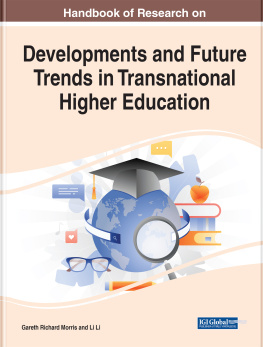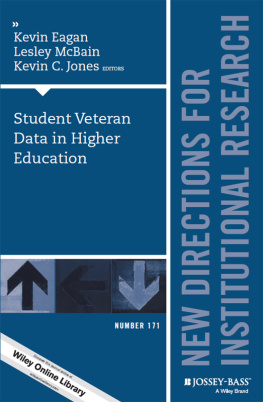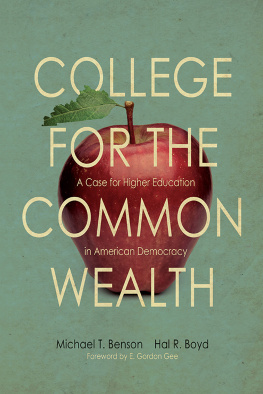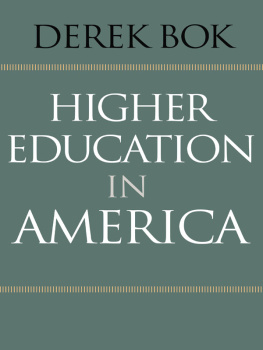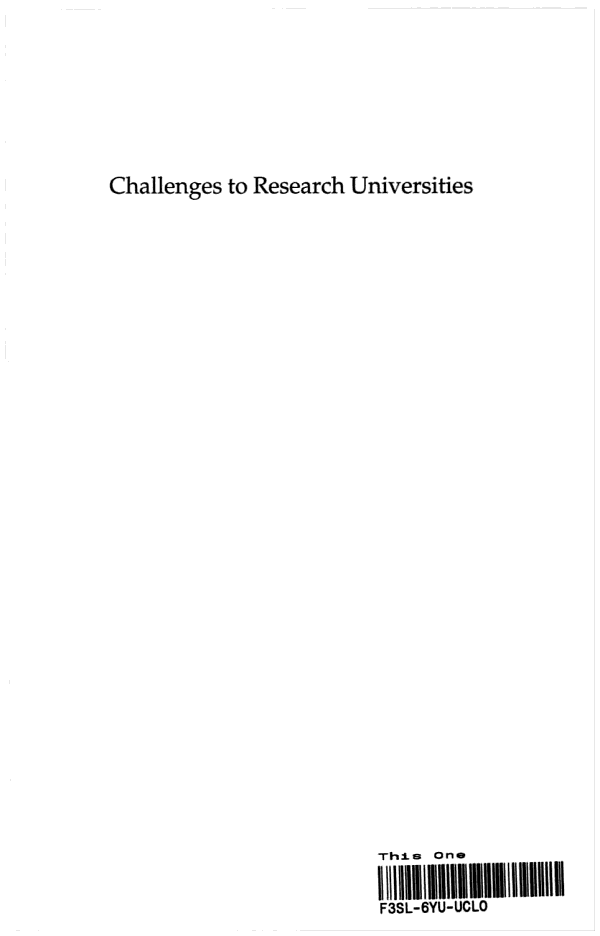
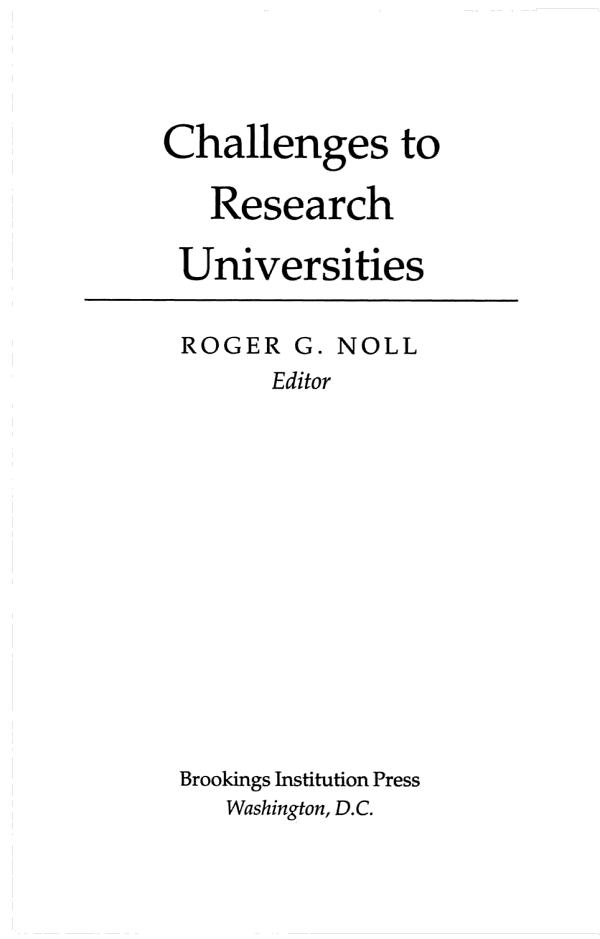
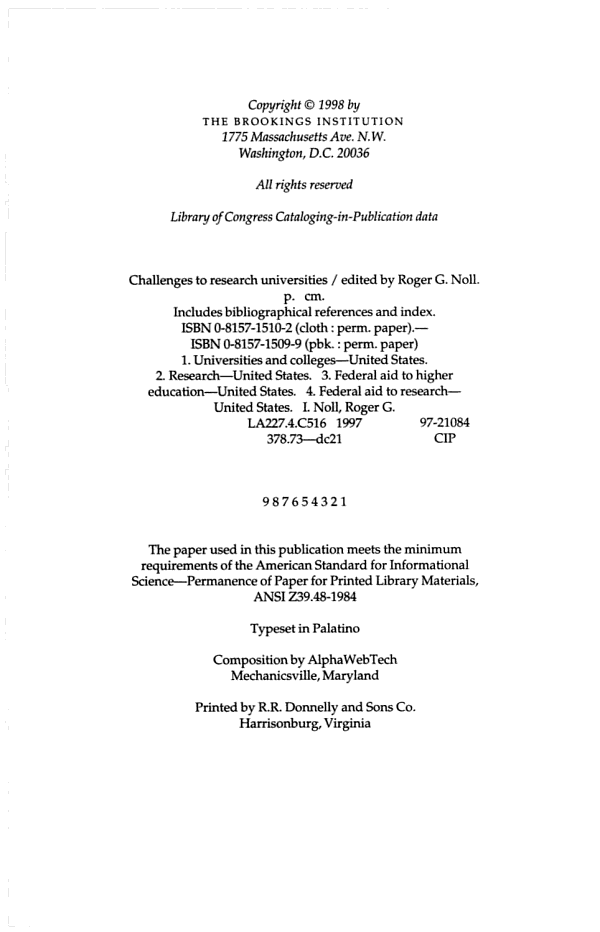

Foreword
The American system of higher education is unusual in many ways. In most of the world nearly all higher education is provided by large public institutions, but in the United States colleges and universities are remarkably diverse in their mission, ownership, scale, and scope. Among American colleges and universities, an elite set of about 100 institutions does many things in addition to educating students. These institutions perform most of the nation0s basic research, provide a substantial amount of medical care (especially the most technically demanding services), and supply athletic entertainment to national television audiences. In most of the world, institutions of higher education serve primarily an educational purpose, leaving basic research, medical care, and athletics to other organizations.
Though American higher education has experienced periods of financial difficulty, the twentieth century has witnessed remarkable growth, especially since World War II. State governments have poured more and more dollars into public institutions to accommodate the steadily increasing number of young adults who desire higher education. The federal government has likewise supported higher education through grant and loan programs for students from lower-income families, educational benefits programs for veterans, basic research grants (especially in science and engineering), generous policies for reimbursing teaching hospitals for services provided to medicare patients, and income tax deductions for contributions to universities by businesses and individuals.
In the 1990s virtually all forms of public support for higher education began to decline. State appropriations for higher education began to shrink, and cost containment programs in health care turned many university medical centers into sources of major financial losses. Basic research grants to universities continued to grow in most fields, but in some major areasespecially engineeringfederal support fell with the cutbacks in defense expenditures. Moreover, forecasts for reaching compliance with the agreement to balance the federal budget included significant cutbacks in university research after the year 2000. These trends have led some observers to wonder whether the golden era of the American research university is drawing to a close.
To assess the future of the research university, the Brookings Institution, through its Brown Center on Education Research, brought together a group of scholars to study the factors that are most likely to influence research universities in the coming years. The project was designed to assess the state of research universities with respect to their primary customers or client-supporters, including students, state and federal government, private industry, and third-party payers for medical services.
The problem facing research universities is not that they are performing poorly in terms of their primary social goals. The economic benefits of higher education are large and growing more rapidly than the increase in the cost of higher education, while an increasing proportion of the population attends college despite rising tuition and fees. In basic research and advanced medical services, U.S. institutions lead the world in new discoveries and useful inventions. Instead, the problem has been that state and federal governments have, until recently, seemed less willing to pay for most of these outputs of research universities. Universities have therefore turned to students (through tuition increases) and industry (through applied research collaborations) for an increasing fraction of their income.
These trends probably do not threaten the existence or dominance of elite American research universities, but they are likely to change their character substantially, even if Congress approves administration requests for enhanced federal support of university-based research. Among the conclusions reached by the authors of this study are that universities are likely to place more emphasis on education as they become more reliant on income from students and to withdraw from providing health services. In addition, the growing collaboration with industry may not be sustainable, for the desire for secrecy by industrial partners is incompatible with the broader educational and research missions of the university and may even destroy the value of university research to industry.
Early drafts of the chapters in this book were presented at a conference in June 1996 involving numerous experts on universities from academe and government. The conference and the publication of the book were sponsored by the Brown Center on Education Policy. Additional support for this project was provided by the Carnegie Corporation of New York. The authors are grateful for exceptional administrative support from Gemma Park, the inspiration and ideas of Lois Rice, and the generous assistance from colleagues in the Department of Education, the National Institutes of Health, and the National Science Foundation for guiding them through the confusing mountain of federal data on higher education. In addition they thank Steph Selice and Deborah Styles for editing the manuscript, Cynthia Iglesias and Helen Kim for verifying its factual content, Carlotta Ribar for proofreading, and Julia Petrakis for preparing the index.
The views expressed here are those of the authors and should not be ascribed to the trustees, officers, or staff of the Brookings Institution.
Chapter 1
The American Research University: An Introduction
Roger G. Noll
American research universities have enjoyed a wonderful century, rising from a distinctly inferior status to world domination. But in the waning years of this golden age of American science and engineering, the future of these institutions is in doubt. This book explores in depth some of the major issues challenging the strength of U.S. research universities.
The concern that has been expressed by leaders of American higher education is hardly new. In 1983, the Academy of Political Science published a book entitled The Crisis in Higher Education, and the conclusion to its chapter on research universities began: "In order to continue in the style to which they have become accustomed, the research universities in both public and private sectors need a miracle."1 In 1975 the New York Times proclaimed, "private colleges and universities ... are, individually and collectively, in extreme danger," and the president of Dartmouth College opined: "I think the institution of private colleges and universities will survive, but... if present terms continue about half of them are going to go out of business."2 A few years earlier, a detailed economic study of U.S. higher education was titled The New Depression in Higher Education One review of these assessments flatly stated the problem: "An accurate assessment of either the current or prospective financial situation of colleges and uni versities has thus far eluded those who have investigated the subject."4 The skepticism of these authors was valid, for in the years that followed, American research universities enjoyed nothing short of a boom in both revenues and enrollments. Scholars who claim that the long-awaited crisis has finally arrived should approach this topic with humility.


